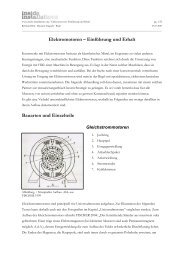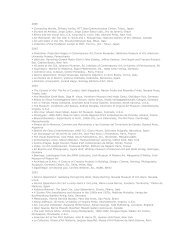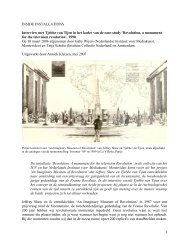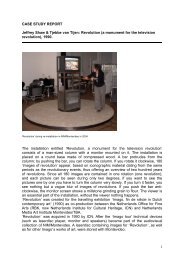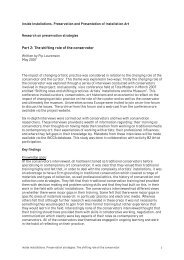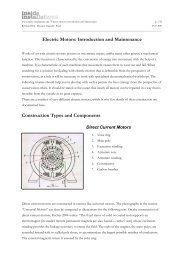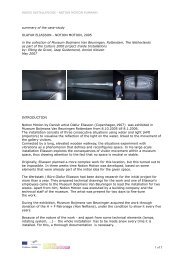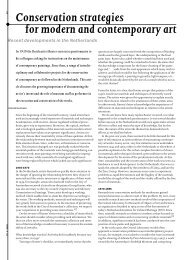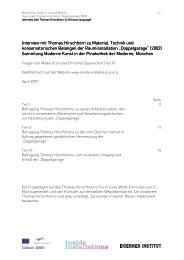GLOSSARY OF LIGHT TECHNOLOGY - Inside Installations
GLOSSARY OF LIGHT TECHNOLOGY - Inside Installations
GLOSSARY OF LIGHT TECHNOLOGY - Inside Installations
You also want an ePaper? Increase the reach of your titles
YUMPU automatically turns print PDFs into web optimized ePapers that Google loves.
WWW.INSIDE-INSTALLATIONS.ORG <strong>GLOSSARY</strong> <strong>OF</strong> <strong>LIGHT</strong> <strong>TECHNOLOGY</strong> FRANZISKA HERZOG ZKM KARLSRUHE 12<br />
Electromagnetic Transformers<br />
Electronic Ballasts<br />
Electronic Transformers<br />
are also known as conventional transformers.<br />
Here it deals with > transformers which are used to regulate electrical<br />
current in > electrical light sources, e.g. in > high voltage light<br />
tubes.<br />
Conventional transformers, simply put, consist of an iron core and at<br />
least one multiply tapped wire coil or several coils.<br />
Current generation is brought about through > induction. A change in<br />
the magnetic flow of the first coil in the primary circuit is caused<br />
by the application of an alternating current and causes a voltage<br />
induction (> primary voltage). The altered magnetic flow carries through<br />
the second coil in a secondary circuit and by induction generates a<br />
further voltage (secondary voltage). A continuously changing voltage,<br />
i.e. an alternating voltage is thus necessary for the operation of<br />
transformers. The maximum level of inducted voltage depends not only<br />
on the initial voltage but also on the number of windings in the coil.<br />
The maximum level of current depends on the construction, i.e. on the<br />
size and on the cross-section of the conductor, and the properties of<br />
the material (of the iron core etc.). With larger constructions, the<br />
power loss must be countered with cooling as transformers overheat if<br />
the overload is too great, i.e. they can “burn out”.<br />
Due to the relatively high inner resistance|inductive resistance (><br />
electrical resistance) of electromagnetic transformers there is a<br />
negative effect on the lifetime and the > luminous flux of the lamp<br />
according to the load created. To prevent the destruction of the<br />
device due to an increased current from the inner resistance during a<br />
short circuit, a thermal fuse|thermal switch is necessary.<br />
There are various constructions which differ in their respective<br />
functions, e.g. short circuit protected and non-short circuit protected<br />
types. Isolating transformers, for example, exhibit separate windings<br />
which generate galvanically separate electrical circuits (> galvanic<br />
isolation) and make possible a protective isolation.<br />
The dimensions and weight of electromagnetic transformers are in<br />
comparison to > electronic transformers relatively high.<br />
> Dimming of conventional transformers is possible by means of a phase<br />
control modulator (> triac).<br />
are > ballasts which are used in > gas discharge lamps.<br />
Electronic ballasts are built-in devices, which are characterised by<br />
the following properties:<br />
Due to their low energy consumption (power loss) as well as the<br />
possibility of saving energy by the use of > dimmers, they guarantee<br />
a high > light output. Electronic ballasts maintain a constant ><br />
luminous flux due to their constant lamp power over a wide range of<br />
mains voltage, constant lamp power and a corresponding long lifetime<br />
of the lamp. Electronic ballasts prevent flickering light. An automatic<br />
shut-off activates when the lamp is defective which makes switching the<br />
light on again immediately possible. Electronic ballasts can be used in<br />
the operation of both alternating and direct voltage. The permissible<br />
operation is indicated on the housing cover (nameplate). They can be<br />
operated with > extra low voltage and thus from batteries.<br />
Electronic ballasts are divided into cold start and warm start<br />
electronic ballasts whereby the flatter are more common and suitable<br />
for the lamp. Warm start ballasts ignite the illuminant after a<br />
preheating period of the electrodes (0.5-2s).<br />
A distinction is also made between dimmable and non-dimmable<br />
electronic ballasts. Dimmable electronic ballasts are operated by<br />
control devices, which can be analogue (> 1-10V interface) or digital<br />
(> DALI). Sensors are applied when the > power is regulated according<br />
to the amount of daylight.<br />
Important parameters of electronic ballasts are the maximum permissible<br />
housing temperature (t c max. ) and the surrounding air temperature<br />
(t a max. ). Operation outside these parameters has a negative effect on<br />
the lifetime of the ballast. All of these parameters are found on<br />
the housing cover (nameplate). Electronic ballasts are available in<br />
small, compact forms, which integrate all the parts of the device. The<br />
construction varies according to the type of lamp and the manufacturer.<br />
For example, in fluorescent lamps the form is oblong and ovular as<br />
opposed to compact fluorescent lamps where the form is rectangular.<br />
are > transformers which are used in > electrical light sources to<br />
regulate current, e.g. in > light emitting diodes.<br />
The construction of electronic transformers corresponds to that of ><br />
switched mode power supplies. Due to their low energy consumption they<br />
have a lower power loss than > electromagnetic transformers which has<br />
a positive effect on the > luminous flux and the > light output of the<br />
lamp. As heating in the housing is reduced, they are more efficient in<br />
dealing with a wide variety of loads.



